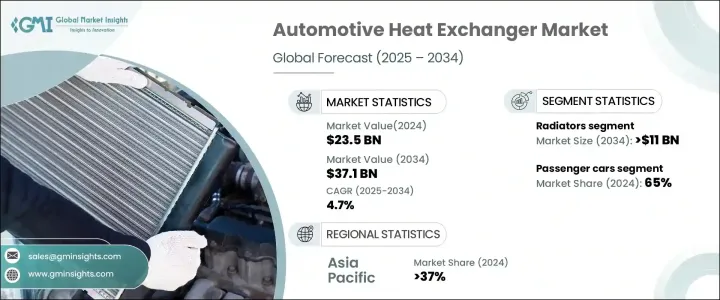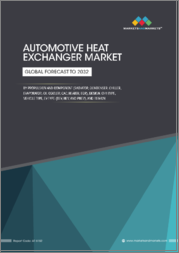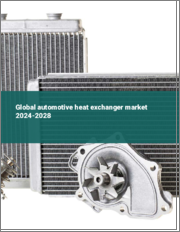
|
시장보고서
상품코드
1698252
자동차용 열교환기 시장 : 시장 기회, 성장 촉진요인, 산업 동향 분석, 예측(2025-2034년)Automotive Heat Exchanger Market Opportunity, Growth Drivers, Industry Trend Analysis, and Forecast 2025-2034 |
||||||
세계의 자동차용 열교환기 시장 규모는 2024년에 235억 달러로 평가되었으며, 2025-2034년 CAGR 4.7%로 성장할 것으로 예측됩니다.
전기자동차(EV)의 보급이 진행되어 세계적으로 배기가스 규제가 엄격해지고 있는 것이 효율적인 열관리 솔루션 수요를 촉진하고 있습니다. 충전 인프라의 개선 및 부품 비용의 저하로 EV의 보급이 진행되어 열관리 시스템에 대한 요구가 높아지고 있습니다. EV에 널리 사용되는 리튬이온전지는 수명 및 성능을 확보하기 위해 15℃-35℃ 범위에서 안정적인 온도 제어가 필요합니다. 열교환기는 배터리 상태를 최적으로 유지하고 과열을 막아 배터리 수명을 늘리는 데 도움이 됩니다. 하이브리드 자동차 또한 내연 엔진과 전기 모터의 온도를 조정하고 효율적인 운전을 확보하기 위해 이러한 시스템에 의존하고 있습니다.

미국, 영국, 중국 등 다양한 국가의 정부가 배기가스 규제를 강화하고 있기 때문에 자동차 제조업체는 첨단 열관리 솔루션을 개발할 필요가 있습니다. 배기가스 재순환(EGR) 시스템과 같은 기술은 질소 산화물 배출을 줄이고 연료 효율을 높이기 위해 도입되었습니다. 지속가능성이 중시됨에 따라 열관리에 있어서 기술 혁신은 더욱 가속화되어 열교환기는 현대자동차에 있어서 매우 중요한 부품이 되고 있습니다.
| 시장 범위 | |
|---|---|
| 시작 연도 | 2024년 |
| 예측 연도 | 2025-2034년 |
| 시작 금액 | 235억 달러 |
| 예측 금액 | 371억 달러 |
| CAGR | 4.7% |
자동차용 열교환기 시장은 제품별로 분류되며, 2024년 시장 점유율은 라디에이터가 30% 이상으로 1위를 차지했으며, 2034년에는 110억 달러 이상에 달할 것으로 예측됩니다. 라디에이터는 특히 내연기관(ICE) 차량에서 엔진 냉각, 과열 방지, 연비 최적화에 필수적입니다. 대체 연료의 대두에도 불구하고, 가솔린차 및 디젤차는 비용과 입수의 용이성 때문에 여전히 보급되고 있어 효율적인 냉각 시스템의 수요를 강화하고 있습니다.
차량 유형별로는 승용차가 2024년 시장 점유율의 65%를 차지했으며, 그 보급이 견인하고 있습니다. 열교환기는 안전성, 쾌적성, 운전 효율을 확보하기 위해 이러한 자동차에서 매우 중요합니다. 자동차 수요의 증가는 엔진 성능과 수명을 유지하기 위한 라디에이터, 오일 쿨러, 콘덴서를 포함한 적당한 방사열 관리 시스템의 채택에 박차를 가하고 있습니다.
배출가스 억제를 위한 정부의 대처가 열관리 솔루션의 진보로 이어지고 있습니다. 미국 CO2 배출량의 약 31%는 자동차에서 기인하고 있어 규제 강화 및 기술 강화의 필요성이 강조되고 있습니다. 열교환기 시스템의 강화는 이러한 진화하는 기준을 충족시키기 위해 점점 자동차에 편입되게 되고 있으며, 시장의 성장을 더욱 뒷받침하고 있습니다.
재료별로는 알루미늄이 2024년 시장을 독점했으며, 이것은 그 비용대효과, 경량성, 고열 전도성에 기인합니다. 자동차 업계는 연비와 차량 성능을 향상시키기 위해 보다 경량인 재료로 전환하고 있으며 알루미늄은 내구성과 내부식성으로 인해 바람직한 선택지로 떠오르고 있습니다. 이로 인해 부품의 수명이 늘어나 제조사 및 소비자의 장기적인 비용 절감으로 이어집니다.
판매 채널에서는 주문자 상표 부착 제조업체(OEM)가 2024년에 큰 점유율을 차지했습니다. 자동차 제조업체는 열교환기 제조업체와 긴밀하게 제휴해, 차량 사양에 맞춘 표준 부품이나 커스텀 부품을 개발하고 있습니다. EV나 하이브리드차 시장의 확대에 의해, OEM 메이커와 열교환기 메이커와의 제휴가 증가해 생산 및 통합 프로세스의 합리화가 진행되고 있습니다.
2024년 자동차용 열교환기 시장은 아시아태평양이 37%의 점유율로 선도했습니다. 중국이 여전히 우세하여 2034년에는 30억 달러에 이를 것으로 예측되고 있습니다. 이 지역의 강력한 자동차 생산 기반은 낮은 생산 비용 및 낮은 인건비와 맞물려 세계 자동차 회사를 끌어들여 열교환기 부품에 대한 높은 수요를 견인하고 있습니다. 게다가 이 지역의 자동차 보유 대수가 많기 때문에, 열교환기 부품의 애프터 마켓도 번성해, 안정적인 교환 수요가 있습니다.
목차
제1장 조사 방법 및 조사 범위
- 조사 디자인
- 조사 접근
- 데이터 수집 방법
- 기본 추정 및 계산
- 기준 연도의 산출
- 시장 추계의 주요 동향
- 예측 모델
- 1차 조사 및 검증
- 시장 범위 및 정의
제2장 주요 요약
제3장 업계 인사이트
- 생태계 분석
- 공급자의 상황
- 원재료 공급자
- 열교환기 제조업체
- 유통업체
- 최종 용도
- 이익률 분석
- 기술 및 혁신의 전망
- 특허 분석
- 주요 뉴스
- 가격 동향
- 규제 상황
- 영향요인
- 성장 촉진요인
- 전기차 및 하이브리드차의 성장
- 엄격한 배기 가스 및 연비 규제
- 열교환기 재료의 진보
- 자동차 생산 및 수요 증가
- 업계의 잠재적 위험 및 과제
- 높은 재료비 및 제조 비용
- 열 관리 시스템의 복잡성
- 성장 촉진요인
- 성장 가능성 분석
- Porter's Five Forces 분석
- PESTEL 분석
제4장 경쟁 구도
- 서문
- 기업 점유율 분석
- 경쟁 포지셔닝 매트릭스
- 전략 전망 매트릭스
제5장 시장 추계 및 예측 : 제품별(2021-2034년)
- 주요 동향
- 라디에이터
- 인터쿨러
- 오일 쿨러
- 배기 가스 재순환(EGR)
- 기타
제6장 시장 추계 및 예측 : 차량별(2021-2034년)
- 주요 동향
- 승용차
- 세단
- SUV
- 해치백
- 상용차
- LCV
- HCV
- 오프 고속도로 자동차
제7장 시장 추계 및 예측 : 재료별(2021-2034년)
- 주요 동향
- 알루미늄
- 구리
- 기타
제8장 시장 추계 및 예측 : 디자인별(2021-2034년)
- 주요 동향
- 플레이트 바
- 튜브핀
- 기타
제9장 시장 추계 및 예측 : 판매 채널별(2021-2034년)
- 주요 동향
- OEM
- 애프터마켓
제10장 시장 추계 및 예측 : 지역별(2021-2034년)
- 주요 동향
- 북미
- 미국
- 캐나다
- 유럽
- 영국
- 독일
- 프랑스
- 이탈리아
- 스페인
- 러시아
- 북유럽
- 아시아태평양
- 중국
- 인도
- 일본
- 호주
- 한국
- 동남아시아
- 라틴아메리카
- 브라질
- 멕시코
- 아르헨티나
- 중동 및 아프리카
- UAE
- 남아프리카
- 사우디아라비아
제11장 기업 프로파일
- Ahaus Tool &Engineering
- AKG Group
- American Industrial Heat Transfer
- Banco Products
- Denso
- G&M Radiator
- Hanon Systems
- HAUGG Group
- Koyorad
- Mahle
- Modine Manufacturing
- Nippon Light Metals
- Nissens
- SM Auto Engineering
- Sanden
- Senior
- Spectra Premium
- T.RAD Co.
- Tokyo Radiator
- Valeo
The Global Automotive Heat Exchanger Market was valued at USD 23.5 billion in 2024 and is projected to grow at a CAGR of 4.7% from 2025 to 2034. The increasing adoption of electric vehicles (EVs) and stringent emission regulations worldwide are driving demand for efficient heat management solutions. With improvements in charging infrastructure and declining component costs, EV adoption is rising, leading to a greater need for thermal management systems. Lithium-ion batteries, widely used in EVs, require stable temperature control within 15°C to 35°C to ensure longevity and performance. Heat exchangers help maintain optimal battery conditions, preventing overheating and extending battery life. Hybrid vehicles also rely on these systems to regulate temperatures for both internal combustion engines and electric motors, ensuring efficient operation.

Governments in various countries, including the US, UK, and China, are enforcing stricter emissions policies, prompting automakers to develop advanced heat management solutions. Technologies like exhaust gas recirculation (EGR) systems are being incorporated to reduce nitrogen oxide emissions and enhance fuel efficiency. The growing emphasis on sustainability has further accelerated innovations in thermal management, making heat exchangers a crucial component in modern vehicles.
| Market Scope | |
|---|---|
| Start Year | 2024 |
| Forecast Year | 2025-2034 |
| Start Value | $23.5 Billion |
| Forecast Value | $37.1 Billion |
| CAGR | 4.7% |
The automotive heat exchanger market is categorized by product, with radiators leading at over 30% market share in 2024 and expected to surpass USD 11 billion by 2034. Radiators are essential for engine cooling, preventing overheating, and optimizing fuel efficiency, particularly in internal combustion engine (ICE) vehicles. Despite the rise of alternative fuels, gasoline and diesel vehicles remain prevalent due to cost and accessibility, reinforcing the demand for efficient cooling systems.
By vehicle type, passenger cars accounted for 65% of the market share in 2024, driven by their widespread usage. Heat exchangers are critical in these vehicles for ensuring safety, comfort, and operational efficiency. The increasing demand for automobiles is fueling the adoption of moderate radiation heat management systems that include radiators, oil coolers, and condensers to maintain engine performance and longevity.
Government initiatives to curb emissions are leading to advancements in thermal management solutions. Approximately 31% of CO2 emissions in the US originate from vehicles, emphasizing the need for stricter regulations and technological enhancements. Enhanced heat exchanger systems are increasingly integrated into vehicles to meet these evolving standards, further propelling market growth.
Material-wise, aluminum dominated the market in 2024, attributed to its cost-effectiveness, lightweight nature, and high thermal conductivity. The automotive industry is shifting towards more lightweight materials to improve fuel efficiency and vehicle performance, with aluminum emerging as the preferred choice due to its durability and resistance to corrosion. This extends component lifespan, reducing long-term costs for manufacturers and consumers.
In terms of sales channels, original equipment manufacturers (OEMs) held a significant share in 2024. Automakers collaborate closely with heat exchanger manufacturers to develop standard and custom components tailored to vehicle specifications. The growing EV and hybrid vehicle market has led to increased partnerships between OEMs and heat exchanger suppliers, streamlining production and integration processes.
Asia Pacific led the automotive heat exchanger market with a 37% share in 2024. China remains the dominant player, projected to reach USD 3 billion by 2034. The region's strong automobile manufacturing base, combined with lower production and labor costs, has attracted global automakers, driving high demand for heat exchanger components. Additionally, the aftermarket for these components is thriving due to the region's high vehicle population, leading to consistent replacement demand.
Table of Contents
Chapter 1 Methodology & Scope
- 1.1 Research design
- 1.1.1 Research approach
- 1.1.2 Data collection methods
- 1.2 Base estimates & calculations
- 1.2.1 Base year calculation
- 1.2.2 Key trends for market estimation
- 1.3 Forecast model
- 1.4 Primary research and validation
- 1.4.1 Primary sources
- 1.4.2 Data mining sources
- 1.5 Market scope & definition
Chapter 2 Executive Summary
- 2.1 Industry 3600 synopsis, 2021 - 2034
Chapter 3 Industry Insights
- 3.1 Industry ecosystem analysis
- 3.2 Supplier landscape
- 3.2.1 Raw material suppliers
- 3.2.2 Heat exchanger manufacturers
- 3.2.3 Distributors
- 3.2.4 End Use
- 3.3 Profit margin analysis
- 3.4 Technology & innovation landscape
- 3.5 Patent analysis
- 3.6 Key news & initiatives
- 3.7 Price trend
- 3.8 Regulatory landscape
- 3.9 Impact forces
- 3.9.1 Growth drivers
- 3.9.1.1 Growth of electric and hybrid vehicles
- 3.9.1.2 Stringent emissions and fuel efficiency regulations
- 3.9.1.3 Advancements in heat exchanger material
- 3.9.1.4 Increasing vehicle production and demand
- 3.9.2 Industry pitfalls & challenges
- 3.9.2.1 High material and manufacturing costs
- 3.9.2.2 Complexity of thermal management systems
- 3.9.1 Growth drivers
- 3.10 Growth potential analysis
- 3.11 Porter’s analysis
- 3.12 PESTEL analysis
Chapter 4 Competitive Landscape, 2024
- 4.1 Introduction
- 4.2 Company market share analysis
- 4.3 Competitive positioning matrix
- 4.4 Strategic outlook matrix
Chapter 5 Market Estimates & Forecast, By Product, 2021 - 2034 ($Bn, Units)
- 5.1 Key trends
- 5.2 Radiators
- 5.3 Intercoolers
- 5.4 Oil coolers
- 5.5 Exhaust gas recirculation (EGR)
- 5.6 Others
Chapter 6 Market Estimates & Forecast, By Vehicle, 2021 - 2034 ($Bn, Units)
- 6.1 Key trends
- 6.2 Passenger cars
- 6.2.1 Sedan
- 6.2.2 SUV
- 6.2.3 Hatchback
- 6.3 Commercial vehicle
- 6.3.1 LCV
- 6.3.2 HCV
- 6.4 Off highway vehicle
Chapter 7 Market Estimates & Forecast, By Material, 2021 - 2034 ($Bn, Units)
- 7.1 Key trends
- 7.2 Aluminum
- 7.3 Copper
- 7.4 Others
Chapter 8 Market Estimates & Forecast, By Design, 2021 - 2034 ($Bn, Units)
- 8.1 Key trends
- 8.2 Plate bar
- 8.3 Tube fin
- 8.4 Others
Chapter 9 Market Estimates & Forecast, By Sales Channel, 2021 - 2034 ($Bn, Units)
- 9.1 Key trends
- 9.2 OEM
- 9.3 Aftermarket
Chapter 10 Market Estimates & Forecast, By Region, 2021 - 2034 ($Bn, Units)
- 10.1 Key trends
- 10.2 North America
- 10.2.1 U.S.
- 10.2.2 Canada
- 10.3 Europe
- 10.3.1 UK
- 10.3.2 Germany
- 10.3.3 France
- 10.3.4 Italy
- 10.3.5 Spain
- 10.3.6 Russia
- 10.3.7 Nordics
- 10.4 Asia Pacific
- 10.4.1 China
- 10.4.2 India
- 10.4.3 Japan
- 10.4.4 Australia
- 10.4.5 South Korea
- 10.4.6 Southeast Asia
- 10.5 Latin America
- 10.5.1 Brazil
- 10.5.2 Mexico
- 10.5.3 Argentina
- 10.6 MEA
- 10.6.1 UAE
- 10.6.2 South Africa
- 10.6.3 Saudi Arabia
Chapter 11 Company Profiles
- 11.1 Ahaus Tool & Engineering
- 11.2 AKG Group
- 11.3 American Industrial Heat Transfer
- 11.4 Banco Products
- 11.5 Denso
- 11.6 G&M Radiator
- 11.7 Hanon Systems
- 11.8 HAUGG Group
- 11.9 Koyorad
- 11.10 Mahle
- 11.11 Modine Manufacturing
- 11.12 Nippon Light Metals
- 11.13 Nissens
- 11.14 S.M. Auto Engineering
- 11.15 Sanden
- 11.16 Senior
- 11.17 Spectra Premium
- 11.18 T.RAD Co.
- 11.19 Tokyo Radiator
- 11.20 Valeo


















